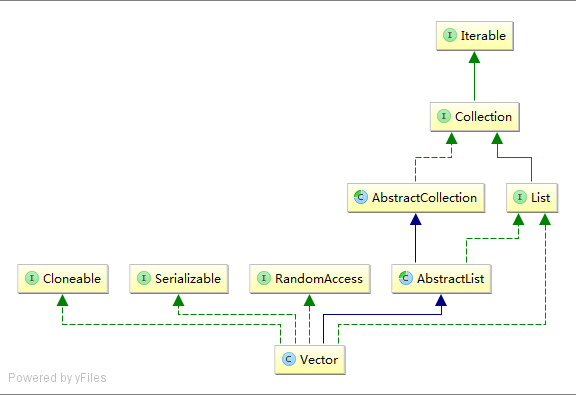java源码-vector
开篇
Vector 类可以实现可增长的对象数组。与数组一样,它包含可以使用整数索引进行访问的组件。但是,Vector 的大小可以根据需要增大或缩小,以适应创建 Vector 后进行添加或移除项的操作。Vector 是同步的,可用于多线程。
Vector 是线程安全版本的ArrayList,这点可以从后续的源码中看出来,基本上增删改查都是用关键synchronized进行修饰。
ArrayList的出现估计为了降低锁的使用吧,否则跟vector相比几乎是一模一样的。
vector类图

vector类图及构造函数
vector的类变量和构造函数都比较简单,相比ArrayList而言,vector有参数可以指定扩容的增量capacityIncrement,其他的跟ArrayList是一致的。
public class Vector<E>
extends AbstractList<E>
implements List<E>, RandomAccess, Cloneable, java.io.Serializable
{
//保存元素的数组
protected Object[] elementData;
//记录元素个数
protected int elementCount;
//记录Vector扩容的速度
protected int capacityIncrement;
private static final long serialVersionUID = -2767605614048989439L;
public Vector(int initialCapacity, int capacityIncrement) {
super();
if (initialCapacity < 0)
throw new IllegalArgumentException("Illegal Capacity: "+
initialCapacity);
this.elementData = new Object[initialCapacity];
this.capacityIncrement = capacityIncrement;
}
public Vector(int initialCapacity) {
this(initialCapacity, 0);
}
public Vector() {
this(10);
}
public Vector(Collection<? extends E> c) {
elementData = c.toArray();
elementCount = elementData.length;
// c.toArray might (incorrectly) not return Object[] (see 6260652)
if (elementData.getClass() != Object[].class)
elementData = Arrays.copyOf(elementData, elementCount, Object[].class);
}
vector日常操作
vector添加元素
vector的add操作跟ArrayList一个重要的不同就是通过synchronized进行了修饰保证线程安全,其他跟ArrayList保持一致,在add元素的时候会先grow一下新的容量而已。
public synchronized void addElement(E obj) {
modCount++;
ensureCapacityHelper(elementCount + 1);
elementData[elementCount++] = obj;
}
public void add(int index, E element) {
insertElementAt(element, index);
}
public synchronized void insertElementAt(E obj, int index) {
modCount++;
if (index > elementCount) {
throw new ArrayIndexOutOfBoundsException(index
+ " > " + elementCount);
}
ensureCapacityHelper(elementCount + 1);
System.arraycopy(elementData, index, elementData, index + 1, elementCount - index);
elementData[index] = obj;
elementCount++;
}
private void ensureCapacityHelper(int minCapacity) {
if (minCapacity - elementData.length > 0)
grow(minCapacity);
}
private void grow(int minCapacity) {
// overflow-conscious code
int oldCapacity = elementData.length;
int newCapacity = oldCapacity + ((capacityIncrement > 0) ?
capacityIncrement : oldCapacity);
if (newCapacity - minCapacity < 0)
newCapacity = minCapacity;
if (newCapacity - MAX_ARRAY_SIZE > 0)
newCapacity = hugeCapacity(minCapacity);
elementData = Arrays.copyOf(elementData, newCapacity);
}
vector删除元素
vector的remove操作也通过synchronized进行修饰,其他的remove动作和ArrayList是一致的。
public synchronized E remove(int index) {
modCount++;
if (index >= elementCount)
throw new ArrayIndexOutOfBoundsException(index);
E oldValue = elementData(index);
int numMoved = elementCount - index - 1;
if (numMoved > 0)
System.arraycopy(elementData, index+1, elementData, index,
numMoved);
elementData[--elementCount] = null; // Let gc do its work
return oldValue;
}
public synchronized void removeAllElements() {
modCount++;
// Let gc do its work
for (int i = 0; i < elementCount; i++)
elementData[i] = null;
elementCount = 0;
}
vector查找元素
vector查找同样用synchronized变量修饰,保证了线程安全。其他的就是按照下标去查找元素而已。
public synchronized E get(int index) {
if (index >= elementCount)
throw new ArrayIndexOutOfBoundsException(index);
return elementData(index);
}
E elementData(int index) {
return (E) elementData[index];
}
public int indexOf(Object o) {
return indexOf(o, 0);
}
public synchronized int indexOf(Object o, int index) {
if (o == null) {
for (int i = index ; i < elementCount ; i++)
if (elementData[i]==null)
return i;
} else {
for (int i = index ; i < elementCount ; i++)
if (o.equals(elementData[i]))
return i;
}
return -1;
}
vector迭代器
vector的迭代器同样使用了synchronized变量进行了修饰保证线程安全,迭代器的内部实现中hasNext通过比较index是否超出下标上限来实现,next通过移动下标往前迭代。
public synchronized Iterator<E> iterator() {
return new Itr();
}
private class Itr implements Iterator<E> {
int cursor; // index of next element to return
int lastRet = -1; // index of last element returned; -1 if no such
int expectedModCount = modCount;
// 判断是否存在下一个元素
public boolean hasNext() {
// Racy but within spec, since modifications are checked
// within or after synchronization in next/previous
return cursor != elementCount;
}
// 查找下一个元素
public E next() {
synchronized (Vector.this) {
checkForComodification();
int i = cursor;
if (i >= elementCount)
throw new NoSuchElementException();
cursor = i + 1;
return elementData(lastRet = i);
}
}
//判断遍历过程中是否发生数据变化
final void checkForComodification() {
if (modCount != expectedModCount)
throw new ConcurrentModificationException();
}
}




